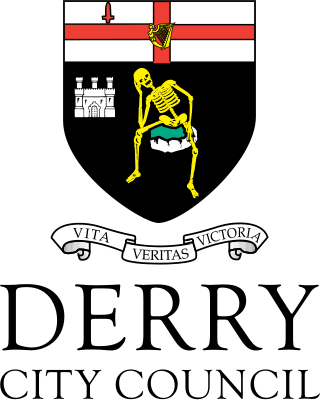The Social Democratic and Labour Party is a social-democratic and Irish nationalist political party in Northern Ireland. The SDLP currently has seven members in the Northern Ireland Assembly (MLAs) and two members of Parliament (MPs) in the House of Commons of the United Kingdom.

The 1998 Northern Ireland Assembly election took place on Thursday, 25 June 1998. This was the first election to the new devolved Northern Ireland Assembly. Six members from each of Northern Ireland's eighteen Westminster Parliamentary constituencies were elected by single transferable vote, giving a total of 108 Members of the Legislative Assembly (MLAs).

The 2003 Northern Ireland Assembly election was held on Wednesday, 26 November 2003, after being suspended for just over a year. It was the second election to take place since the devolved assembly was established in 1998. Each of Northern Ireland's eighteen Westminster Parliamentary constituencies elected six members by single transferable vote, giving a total of 108 Members of the Legislative Assembly (MLAs). The election was contested by 18 parties and many independent candidates.
The Sunningdale Agreement was an attempt to establish a power-sharing Northern Ireland Executive and a cross-border Council of Ireland. The agreement was signed by the British and Irish governments at Northcote House in Sunningdale Park, located in Sunningdale, Berkshire, on 9 December 1973. Unionist opposition, violence and a general strike caused the collapse of the agreement in May 1974.

The Vanguard Unionist Progressive Party (VUPP), informally known as Ulster Vanguard, was a unionist political party which existed in Northern Ireland between 1972 and 1978. Led by William Craig, the party emerged from a split in the Ulster Unionist Party (UUP) and was closely affiliated with several loyalist paramilitary groups. The party was set up in opposition to power sharing with Irish nationalist parties. It opposed the Sunningdale Agreement and was involved in extra-parliamentary activity against the agreement. However, in 1975, during discussions on the constitutional status of Northern Ireland in the constitutional convention, William Craig suggested the possibility of voluntary power sharing with the nationalist Social Democratic and Labour Party. In consequence the party split, with dissenters forming the United Ulster Unionist Party. Thereafter Vanguard declined and following poor results in the 1977 local government elections, Craig merged the remainder of Vanguard into the UUP in February 1978.

Derry City Council was the local government authority for the city of Derry in Northern Ireland. It merged with Strabane District Council in April 2015 under local government reorganisation to become Derry and Strabane District Council.

The Northern Ireland Assembly established in 1982 represented an ultimately unsuccessful attempt to restore the devolution to Northern Ireland which had been suspended 10 years previously. The Assembly was dissolved in 1986.

The Belfast South by-election was held on 4 March 1982 following the death of Robert Bradford, Ulster Unionist Party (UUP) Member of Parliament for Belfast South.

Elections to Belfast City Council were held on 30 May 1973 on the same day as the other Northern Irish local government elections. The election used eight district electoral areas to elect a total of 51 councillors.
Elections to Belfast City Council were held on 18 May 1977 on the same day as the other Northern Irish local government elections. The election used nine district electoral areas to elect a total of 51 councillors, most representing the more heavily populated north and west.
Elections to Larne Borough Council were held on 18 May 1977 on the same day as the other Northern Irish local government elections. The election used three district electoral areas to elect a total of 15 councillors.
Elections to Craigavon Borough Council were held on 18 May 1977 on the same day as the other Northern Irish local government elections. The election used four district electoral areas to elect a total of 25 councillors.
Elections to Newry and Mourne District Council were held on 18 May 1977 on the same day as the other Northern Irish local government elections. The election used six district electoral areas to elect a total of 30 councillors.
Elections to Magherafelt District Council were held on 18 May 1977 on the same day as the other Northern Irish local government elections. The election used three district electoral areas to elect a total of 15 councillors.
Elections to Londonderry City Council were held on 20 May 1981 on the same day as the other Northern Irish local government elections. The election used five district electoral areas to elect a total of 27 councillors.
Elections to Londonderry City Council were held on 18 May 1977 on the same day as the other Northern Irish local government elections. The election used five district electoral areas to elect a total of 27 councillors.
Elections to Strabane District Council were held on 18 May 1977 on the same day as the other Northern Irish local government elections. The election used three district electoral areas to elect a total of 15 councillors.
Londonderry Area A, called Derry Area A from 1984, was one of the five district electoral areas in Derry, Northern Ireland which existed from 1973 to 1985. The district elected six members to Londonderry City Council, and formed part of the Londonderry constituencies for the Northern Ireland Assembly and UK Parliament.
Londonderry Area B, called Derry Area B from 1984, was one of the five district electoral areas in Derry, Northern Ireland which existed from 1973 to 1985. The district elected five members to Londonderry City Council, and formed part of the Londonderry constituencies for the Northern Ireland Assembly and UK Parliament.
Londonderry Area D, called Derry Area D from 1984, was one of the five district electoral areas in Derry, Northern Ireland which existed from 1973 to 1985. The district elected five members to Londonderry City Council, and formed part of the Londonderry constituencies for the Northern Ireland Assembly and UK Parliament.








